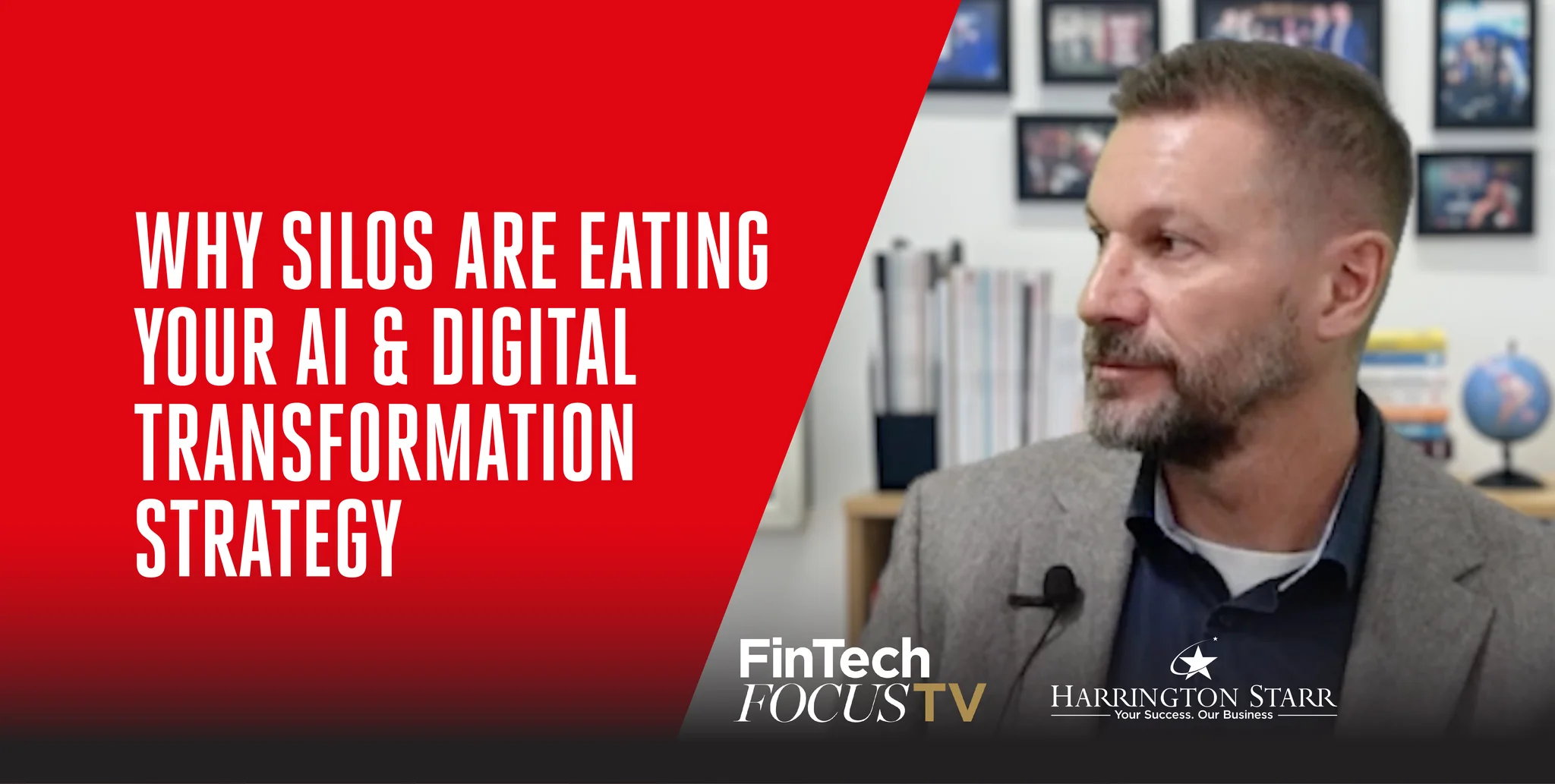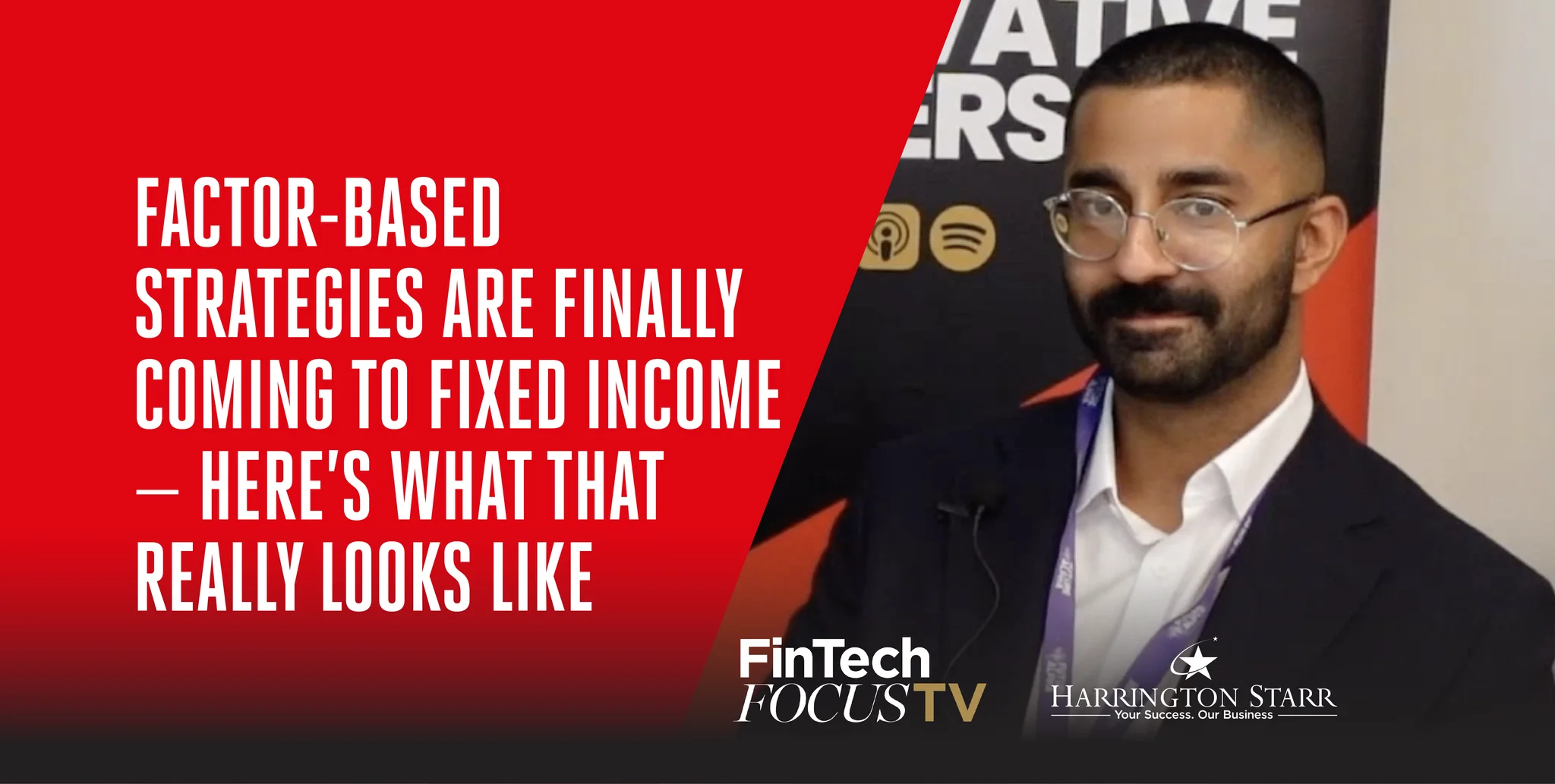Fast, Effective Transformation in FinTech
In this episode of FinTech Focus TV, Toby welcomes Nick Reed, Chief Strategy Officer at Bizzdesign, to discuss one of the most urgent challenges facing modern organisations: how to transform faster and more effectively in an increasingly complex business landscape. Drawing on years of experience helping global enterprises navigate large-scale transformation, Nick unpacks the barriers that slow progress, from organisational silos to the widening gap between strategy and execution, and explains how the right visibility, governance, and architectural approach can help companies thrive in a world increasingly driven by artificial intelligence.
For FinTech businesses and leaders alike, the conversation offers valuable insights into how technology, transformation, and strategy intersect, and what it takes to maintain speed, control, and confidence during constant change.
Bridging the Gap Between Strategy and Execution in FinTech Transformation
Nick begins by explaining that Bizzdesign is built around a single mission: helping organisations transform faster and more effectively. In today’s world, every business must continuously adapt to external forces, from supply chain disruptions and regulatory shifts to geopolitical events and the rapid rise of new technologies. These pressures make transformation essential but also increasingly complex.
According to Nick, the problem is rarely the absence of strategy; it’s the difficulty of turning that strategy into reality. When large organisations attempt to execute on strategic plans, complexity and misalignment quickly appear. Teams struggle to identify what needs to change, how different initiatives interact, and what downstream impacts a decision might have. As a result, projects slow down, budgets spiral, and opportunities are lost.
This is where the concept of silos becomes critical. In Nick’s words, silos “eat strategy for breakfast”. When different divisions or markets operate in isolation, communication breaks down. One team may be building a new solution while another prepares to retire a connected system, leaving both initiatives compromised. In complex organisations, especially large financial institutions, visibility across all these moving parts is limited, and the cost of duplication, delay, and rework can be enormous.
Understanding Silos in Financial Services and FinTech Organisations
While silos exist across industries, Nick notes that the financial services sector provides particularly striking examples. Large banks and financial institutions often operate through multiple lines of business, retail, commercial, investment banking, wealth management, insurance, and asset management, each with its own reporting structures, priorities, and transformation agendas.
The result is that visibility tends to move vertically up and down the command chain, rather than horizontally across the enterprise. This limits collaboration and transparency, especially when multiple geographies and domains are involved. One group may innovate in customer payments while another duplicates the effort unknowingly. Nick recalls hearing from a financial services client who admitted to investing billions in transformation each year, confident that half was wasted, but unsure which half. In one extreme case, a company that grew through more than 20 acquisitions ended up managing over 120 ERP systems, making even the simplest change a monumental challenge.
For FinTech leaders, the lesson is clear: scale and complexity demand new approaches to visibility and coordination. As businesses pursue growth through mergers, acquisitions, and rapid product launches, the need for structured oversight and enterprise-level design becomes ever more critical.
Why FinTech Companies Need “Air Traffic Control” for Change
To overcome these barriers, Bizzdesign provides what Nick calls an “air traffic control system for the enterprise.”The analogy captures the essence of managing transformation at scale, understanding not only where each “plane” (project or initiative) is now, but also where it’s heading and how it interacts with others in flight.
By mapping out business activities, capabilities, processes, technologies, data, and people, organisations can build a living model of their enterprise architecture. This allows them to identify duplication, conflicts, dependencies, and inefficiencies across programmes of work. They can see, for example, where multiple projects target the same strategic goal, or where resources are being spent on initiatives that deliver little value against business objectives.
Once that visibility exists, decision-making improves dramatically. Leaders can anticipate risks, prevent project collisions, and minimise unplanned delays and cost overruns. For recruitment businesses like Harrington Starr, whose FinTech clients are continuously evolving their operations, this kind of clarity is invaluable. Transformation success depends on talent alignment, execution discipline, and the ability to see across silos, areas where architectural insight is a competitive advantage.
The High Cost of Failed Transformation Projects
Both Toby and Nick reflect on the vast sums wasted globally on transformation programmes that never reach completion. Despite careful planning, many initiatives stall during execution. Underestimating complexity, over-promising on timelines, or failing to consider interdependencies can all lead to failure.
Nick highlights that transformation failure often stems from the “strategy to execution gap”, the disconnect between board-level ambitions and operational reality. Without systems and structures to translate strategy into actionable change, even the best-intentioned plans fall apart.
It’s a challenge familiar to many FinTech and financial technology organisations, particularly those balancing regulatory compliance, product innovation, and operational resilience. As Toby notes, transformation failure has become an entire “economy” of its own, with lost time and resources that could otherwise fuel growth and innovation.
To prevent this, Nick argues that transformation must be treated not as a one-off initiative, but as a continuously managed capability, one that requires both visibility and control across the entire enterprise.
The AI Revolution: Promise and Pitfalls for Financial Technology
The discussion naturally turns to the defining topic of recent years, artificial intelligence. Nick explains that AI now dominates every executive agenda. Analysts consistently report it as the number one priority for C-suites globally, often overshadowing other transformation goals.
But the urgency to act can create its own risks. Business leaders eager to capitalise on AI’s potential push their teams to “do something with AI”, often without a clear understanding of what that means. In many cases, AI is used interchangeably with automation, leading to confusion about scope, goals, and impact.
As Nick points out, this pressure to move fast amplifies existing challenges around complexity and silos. IT teams are asked to deliver rapid AI solutions, yet often lack the specialised expertise, frameworks, and governance structures to do so safely. When internal capabilities fall short, employees turn to external tools, free platforms, or unauthorised software, a trend Nick calls “shadow AI”, echoing the long-standing issue of shadow IT.
Shadow AI introduces serious risks: data leakage, privacy violations, compliance breaches, and reputational damage. Nick describes instances of teams feeding proprietary product information into public large language models, only to see sensitive data appear online. The demand to innovate collides with the need to protect, a tension particularly acute in the regulated world of financial technology.
Governance, Risk, and Cultural Friction in the AI Era
Toby and Nick delve into the human side of transformation. When technical teams are asked to work beyond their expertise, stress levels rise and psychological safety declines. Meanwhile, the arrival of AI specialists can cause cultural friction, creating tension between established staff and new hires. In the competitive FinTech talent market, such dynamics can drive attrition and undermine productivity, reinforcing the importance of effective leadership and governance.
Governance, Nick emphasises, doesn’t have to be a dirty word. At its core, it’s about defining who makes which decisions and under what conditions. The challenge lies in finding the right balance. For low-risk initiatives, a light-touch approach encourages speed and experimentation. For high-risk areas, such as payments, personal data, or core trading infrastructure, stricter oversight is essential.
Emerging approaches like “governance as code” or “policy as code” will become increasingly important as autonomous AI agents begin making decisions at machine speed. Encoding governance rules into systems themselves ensures compliance and accountability even when human review isn’t possible in real time.
For businesses in the FinTech recruitment and technology ecosystems, this evolution underscores the growing demand for professionals who combine technical fluency with risk awareness, individuals capable of bridging innovation and control.
Cutting Through Complexity with Enterprise Architecture
The conversation returns to how Bizzdesign enables organisations to make sense of their complexity. By maintaining an up-to-date view of every system, process, and initiative, leaders gain the context they need to make smarter choices.
For example, if multiple customer service teams are experimenting with AI chatbots or predictive analytics, Bizzdesign’s tools can reveal duplication, highlight best practices, and allow successful pilots to be scaled across the organisation. Conversely, it can flag projects that pose compliance risks or deliver minimal strategic value.
This enterprise-wide visibility transforms decision-making from reactive to proactive. It helps prevent fragmentation of data and technology while improving agility and resilience. In Nick’s words, it ensures that innovation doesn’t happen “in a silo”, but in a way that advances overall business goals.
The concept is especially relevant to financial institutions, where the balance between innovation and regulation is delicate. As Toby notes, financial services is a conservative industry for good reason, but it’s also one under constant pressure to improve speed, efficiency, and customer experience. Achieving that balance demands clarity of vision and a framework for change.
Risk, Reward, and the Architecture of Decision-Making
Nick offers an interesting parallel from his early career as a financial journalist writing about derivatives. He recalls that some CFOs once avoided hedging currency risks because they saw derivative contracts as “too risky.” Yet by doing nothing, they were still taking a position, they just lacked visibility of it.
The same principle applies to technology strategy. Building new systems without understanding their architectural context introduces invisible risks and long-term inefficiencies. A quick-fix solution might meet a short-term stakeholder demand, but could increase complexity, fragment data, or duplicate existing capabilities.
Investing time upfront to understand the architectural landscape allows businesses to make informed trade-offs, improving agility and resilience over the long term. It’s a reminder that, in both finance and technology, no decision is still a decision, and often the riskiest one.
AI Portfolio Management: Bringing Order to AI Initiatives
One of Bizzdesign’s newest propositions, AI Portfolio Management, directly addresses this challenge. It provides organisations with a structured way to collect and manage all their AI initiatives in one place.
By cataloguing who is doing what, which business capabilities are being enhanced, what data is being used, and how each project aligns to strategic goals, companies can see their entire AI landscape at a glance. They can identify duplication, monitor costs, assess compliance, and evaluate return on investment.
For FinTech companies racing to integrate AI into customer service, risk management, and trading systems, this holistic view is essential. It enables them to scale what works, retire what doesn’t, and manage risk with confidence. Just as importantly, it connects technology innovation directly to business outcomes, something every financial technology leader strives for.
Delivering Value Across Financial Services and Beyond
Nick explains that Bizzdesign primarily serves large, complex organisations, with financial services representing its largest and most mature market. Banks, insurers, and asset managers face a perfect storm of regulatory pressure, digital transformation, and AI adoption, all of which demand the kind of visibility and governance that Bizzdesign provides.
From operational resilience and compliance to efficiency and innovation, these institutions must navigate a crowded agenda. Yet, as Nick notes, the opportunity is enormous. He cites a former colleague whose AI-powered customer service business grew from zero to over £100 million in recurring revenue in just two years. The potential for transformation is vast; the question is execution.
For Toby, the conversation reinforces the importance of alignment between technology, people, and process, a message that resonates strongly with the recruitment and talent priorities of FinTech firms worldwide. Success in transformation is as much about culture and leadership as it is about tools and systems.
Building the Future of FinTech Transformation
As the episode concludes, Toby and Nick reflect on the importance of clarity, collaboration, and strategic execution in the face of rapid change. Whether tackling silos, managing AI responsibly, or building resilience, the principle remains the same: transformation must be deliberate, data-driven, and connected.
For Harrington Starr, as a FinTech recruitment business partnering with firms across London, New York, and beyond, these lessons are directly relevant. Every major FinTech transformation depends on the right mix of skills, from enterprise architects and change leaders to data engineers, AI specialists, and risk experts. Understanding how strategy connects to execution helps both employers and candidates align their capabilities to the future of the industry.
Nick Reed’s insights offer a roadmap for doing just that. By treating transformation as an ongoing capability, embracing architecture as a source of truth, and balancing innovation with governance, financial technology companies can move faster, smarter, and more securely toward their goals.






